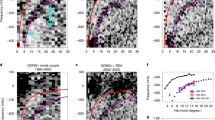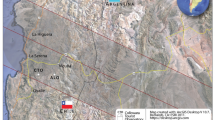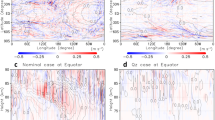Abstract
IT is generally believed that some ionospheric disturbances may be partly caused by the acoustic gravity waves travelling upwards from the troposphere1,2. Wave periods of 5 min to more than 1 h and a narrow spectral band at periods of 7–12 min with a nearly sinusoidal character have been observed2,3. Gossard2 discussed various mechanisms of generation of acoustic gravity waves, but the part that convective storms play in this process is not clear. Pierce and Coroniti4, emphasizing the circumstantial nature of the evidence on which their proposition was based, proposed that air rising rapidly within a thunderstorm cell overshoots the equilibrium height and is pulled back, resulting in oscillations of the air with a period nearly the same as the local Brunt period. These oscillations occur near the cloudtop levels and generate acoustic gravity waves. They also suggested that, although these waves would be strongly attenuated as they propagated downwards, even at ground level they are significant enough to be detected by microbarographs. The wave oscillations may, however, be obscured by the fluctuations in pressure caused by turbulence created by the formation of the thunderstorm. Fullerton5 states that previous studies strongly indicate that sinusoidal pressure variations recorded at the ground are due to tropospheric gravity waves.
This is a preview of subscription content, access via your institution
Access options
Subscribe to this journal
Receive 51 print issues and online access
$199.00 per year
only $3.90 per issue
Buy this article
- Purchase on SpringerLink
- Instant access to full article PDF
Prices may be subject to local taxes which are calculated during checkout
Similar content being viewed by others
References
Hines, C. O., Canad. J. Phys., 38, 1441 (1960).
Gossard, E. E., J. Geophys. Res., 67, 745 (1962).
Gossard, E., and Munk, W., J. Meteorol., 11, 259 (1954).
Pierce, A. D., and Coroniti, S. C., Nature, 210, 1209 (1966).
Fullerton, C. M., thesis, New Mexico Institute of Mining and Technology (1966).
Saucier, W. J., Principles of Meteorological Analysis (Univ. of Chicago Press, 1955).
Showalter, A. K., Bull. Amer. Meteorol. Soc., 34 (1953).
Haltiner, G. J., and Martin, F. L., Dynamical and Physical Meteorology (McGraw-Hill, 1957).
Author information
Authors and Affiliations
Rights and permissions
About this article
Cite this article
MURTY, R., CURRY, M. Microbarographic Observation of Acoustic Gravity Waves. Nature 224, 169–170 (1969). https://doi.org/10.1038/224169b0
Received:
Issue date:
DOI: https://doi.org/10.1038/224169b0
This article is cited by
-
Microbarograph Observation of Acoustic Gravity Waves
Nature (1970)



